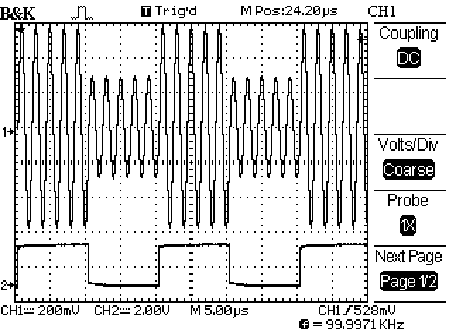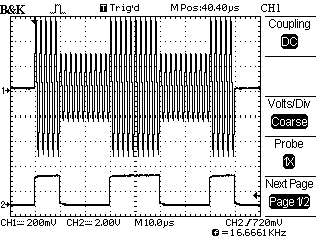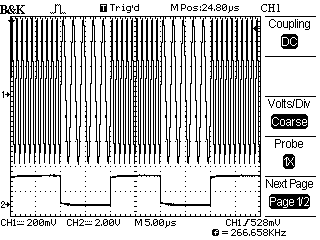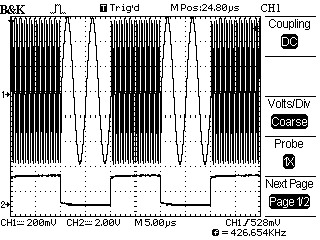Implementation
of
Digital
Modulation
on
SpinCore
PulseBlasterDDS
And
RadioProcessor
Boards
Introduction:
Digital modulation
is used to
transfer a digital bit stream over an analog
channel at a high
frequency.
This enables us to transmit signals generated
in a digital circuit
across a physical medium. This is because
digital signals can be
handled with higher security and digital
systems are readily and widely
available.
Depending on which parameter of the carrier
signal is varied in
accordance with the digital message signal, we
obtain three main
variants of digital modulation called
Amplitude
Shift Keying (ASK), Frequency
Shift Keying (FSK) and Phase
Shift Keying (PSK).
Amplitude
Shift Keying
(ASK)
In ASK the
amplitude of the transmitted
carrier signal is varied in accordance with
the logic levels of the
message signal.
SpinCore
PulseBasterDDS
Board Implementation For ASK:
On the SpinCore
PulseBasterDDS board, the Amplitude Shift
Keying waveform is generated using NCO, by
controlling the gating
and/or
amplitude registers with respect to the input
logic sequence using the
PulseBlaster Timing Core.
The demo source code written here gives the
flexibility of choosing
the different bit rate and the length of the
input sequence and
specifying the amplitude
of the carrier for different logic bits.
Note that the bit rate can not be faster than
(clock/9) for proper
results.
The
complete
C
code demonstrating this implementation is
available for direct download. It uses a
sinusoidal waveform as the carrier signal. The
carrier is
generated using a similar technique to that
used for analog modulation.
Note that this code can be extended to the
more general case of an
M-ary baseband signal as well (such as
quantizing a two or three bits
at a time instead of one bit).
Inputs to the program are:
- Carrier signal frequency
- Amplitude for a logic 1
- Amplitude for a logic 0
- Length of the message signal
- Logic sequence comprising the message
signal.
Output: ASK
modulated
waveform.
If the amplitude level for the carrier wave
transmitted is either "0"
or "1"
for logical values of "0" and "1" respectively
then we can
use the pb_inst_radio
instead of pb_inst_radio_shape.
This
is
because
pb_inst_radio
does
not
allow
us
to
select
amplitude
registers.
The following SpinAPI function is used to load
the Amplitude registers:
pb_set_amp(amp0,
0);
pb_set_amp(amp1,
1);
The total number of amplitude levels in the
carrier waveform depends on
the
total number of the amplitude registers
available on the board being
used. If you would like a board with more
amplitude registers, please
contact SpinCore.
The program allows the user to choose any
amplitude values between 0.0
and
1.0 for the two logic levels. Amplitude
register values are
programmed with respect to the input
logic values and sequence. The sample code is
as shown below for the
same. They are controlled and fed accordingly
by
the PulseBlaster Timing
Core.
for
(i=0;i<length;i++)
{
if(!seq[i])
{
pb_inst_radio_shape(0,0,0,0,
TX_ENABLE,
NO_PHASE_RESET,
NO_TRIGGER,
NO_SHAPE,
0,
0x00,CONTINUE,
0,
tm*us);
}
else
{
pb_inst_radio_shape(0,0,0,0,
TX_ENABLE,
NO_PHASE_RESET,
NO_TRIGGER,
NO_SHAPE,
1,
0x0F,CONTINUE,
0,
tm*us);
}
}
The
parameter passed after the "NO_SHAPE"
parameter
in the above code specifies the correct
amplitude register for the ith
bit in the logic sequence, as specified by the
user.
ASK waveforms generated using the example code
are shown in the figures
below.
|
Figure
1
shows
an
ASK
waveform
generated
using
the
code.
Channel
1
shows
the
output
ASK
for
a
carrier
frequency
of
Fc
=
0.5
MHz and a baseband signal bit rate of
100 kbps. The amplitude for a
logic 0 = 0.0 V and the amplitude for
a logic 1 = 1V. The message
signal was chosen to be the logic
sequence "10101".
Channel
2
shows
the
input
modulating
signal.
i.e.
input
message
(logic
sequence)
signal
with
bit rate = 100 kbps.
|
|

Figure 2
shows
another
ASK waveform generated using the
example code.
Channel
1
shows
the
output
ASK
for
a
carrier
frequency
of
Fc
=
0.5
MHz and a baseband signal bit rate of
100 kbps. The amplitude for a
logic 0 = 0.5 V and the amplitude for
a logic 1 = 1V. The message
signal was chosen to be a logic
sequence "10101".
Channel
2
shows
the
input
modulating
signal.
i.e.
input
message
(logic
sequence)
signal
with
bit rate = 100 kbps.
|
|

Figure
3
shows
output
ASK
waveform
generated
using
the
example
code.
Channel
1 shows the output ASK for a carrier
frequency of Fc = 0.5
MHz and a baseband signal bit
rate of 100 kbps. The amplitude for
a logic 0 = 0.5 V and the amplitude
for a logic 1 = 1V. The message
signal was chosen to be a logic
sequence "10011001".
Channel
2 shows the input modulating signal.
i.e. input message (logic
sequence) signal with bit rate = 100
kbps.
|
Frequency Shift
Keying
(FSK)
In FSK the
frequency of the transmitted
carrier signal
is varied in accordance with the logic of
levels of the message signal
while keeping the
amplitude constant.
SpinCore
PulseBasterDDS
Board Implementation For FSK:
On the SpinCore
PulseBasterDDS board, the Frequency Shift
Keying waveform is generated using the NCO, by
controlling the
frequency
registers with respect to the input logic
sequence using the
PulseBlaster Timing Core.
The demo source code written here gives the
flexibility of choosing a
different bit rate and the length of the input
sequence and
specifying the phase
of the carrier for different logic bits.
Note that the bit rate can not be faster than
(clock/9) for proper
results.
The
complete
C
code demonstrating this implementation is
available for direct download.
It
uses a sinusoidal waveform as a carrier
signal. The carrier is
generated using a similar technique to that
used for analog modulation.
Note that this code can be extended to the
more general case of an
M-ary baseband signal as well.
Inputs are:
- Frequency to transfer for logic 1
- Frequency to transfer for logic 0
- Length of the message signal.
- Logic sequence comprising the message
signal.
Output: FSK modulated waveform.
Following SpinAPI function is used to load the
Frequency registers:
pb_set_freq
(fc1*MHz);
pb_set_freq(fc2*MHz);
Total number of unique frequency changes in
the carrier waveform with
respect to logic levels depends on the total
number of the Frequency
registers available.
The program allows the user to choose any
frequency values between 1
and 100 MHz. for the two logic levels.
Frequency register values are programmed with
respect to the input
logic values and sequence.
They are controlled and fed accordingly by the
PulseBlaster Timing
Core.
The sample code is as shown below for the
same.
for
(i=0;i<length;i++)
{
if(!seq[i])
{
pb_inst_radio(0,0,0,0,
TX_ENABLE,
NO_PHASE_RESET,
NO_TRIGGER,
0x00,CONTINUE,
0,
tm*us);
}
else
{
pb_inst_radio(1,0,0,0,
TX_ENABLE,
NO_PHASE_RESET,
NO_TRIGGER,
0x0F,CONTINUE,
0,
tm*us);
}
}
The first parameter passed in the
pb_inst_radio instruction above
corresponds to the chosen frequency for the
ith bit in the logic
sequence defined by the user.
Outputs for the different frequencies of the
carrier signal
for different logic pulses are shown
below.
|

Figure 4
shows an
FSK waveform generated using the
source code on a PulseBlasterDDS
board.
Channel
1
shows
the
output
FSK
for
a
carrier
frequency
for
logic
level
0 is
Fc(0) = 0.5
MHz and for logic level 1 is Fc(1) = 1
MHz.
Channel
2
shows
the
input
modulating
signal.
i.e.
input
message
(logic
sequence)
signal
with
bit rate = 100 kbps and logic
sequence = "10101".
|
|

Figure 5
shows the
FSK waveform generated using the
example source code but this time with
some different parameters.
Channel
1
shows
the
output
FSK
for
carrier
frequency
for
logic
level
0
is
Fc(0) = 0.2
MHz and for logic level 1 is Fc(1) = 2
MHz.
Channel
2
shows
the
input
modulating
signal.
i.e.
input
message
(logic
sequence)
signal
with
bit rate = 100 kbps and logic
sequence = "10101".
|
|
Figure
6
shows
output
FSK
waveform
generated
using
the
example
source
code
but
with
different
length sequence of input message
signal
Channel
1
shows
the
output
FSK
for
carrier
frequency
with
logic
level
0
is
Fc(0) = 0.2
MHz and for logic level 1 is Fc(1) = 1
MHz.
Channel
2
shows
the
input
modulating
signal.
i.e.
input
message
(logic
sequence)
signal
with
bit rate = 100 kbps and logic
sequence = "10011001".
|
Phase Shift
Keying
(PSK)
In PSK, the
phase of the transmitted
carrier signal
is varied in accordance to the logic of levels
of the message signal
while keeping the
amplitude constant.
SpinCore
PulseBasterDDS
Board Implementation For PSK:
The PSK
implementation
shown here is implemented on the
PulseBlasterDDS
and RadioProcessor boards using similar
methods to FSK.
The Phase Shift
Keying waveform is generated using the NCO, by
controlling the phase
registers with respect to the input logic
sequence using the
PulseBlaster Timing Core.
The demo source code written here gives the
flexibility of choosing
the different bit rate and the length of the
input sequence and
specifying the phase
of the carrier for different logic bits.
Note that the bit rate can not be faster than
(clock/9) for proper
results.
The
complete
C
code demonstrating this implementation is
available for direct download.
It
uses
a
sinusoidal
waveform
as
a
carrier
signal.
The carrier is
generated using a similar technique to that
used for analog modulation.
Note that this code can be extended to the
more general case of an
M-ary baseband signal as well.
Inputs are:
- Phase corresponding to a logic 1
- Phase corresponding to a logic 0
- The frequency of the carrier signal.
- Length of the message signal.
- Logic sequence comprising the message
signal.
Output: PSK modulated waveform.
Following SpinAPI function is used to load the
Phase registers:
pb_set_phase
(phase1);
pb_set_phase(phase2);
The total number of unique phase changes in
the carrier waveform with
respect to logic levels depends on the total
number of the phase
registers available. If you would like to have
more phase registers
available, please contact SpinCore.
The program allows the user to choose any
phase values between 0
and 360 degrees for the two logic levels.
Phase register values are programmed with
respect to the input
logic values and sequence.
They are controlled and fed accordingly by the
PulseBlaster Timing
Core.
The sample code is as shown below for the
same.
for
(i=0;i<length;i++)
{
if(!seq[i])
{
pb_inst_radio(0,0,0,0,
TX_ENABLE,
NO_PHASE_RESET,
NO_TRIGGER,
0x00,CONTINUE,
0,
tm*us);
}
else
{
pb_inst_radio(0,0,0,1,
TX_ENABLE,
NO_PHASE_RESET,
NO_TRIGGER,
0x0F,CONTINUE,
0,
tm*us);
}
}
The fourth parameter above shows the
outputting of the corresponding
phase to the ith bit in the logic sequence, as
defined by the user.
Outputs for the different values of phase of
the carrier signal
for different logic pulses are shown
below.
|
Figure
7
shows
the
PSK
waveform
generated
using
the
example
source
code
on
a
PulseBlasterDDS board.
Channel
1
shows
the
output
PSK
of
a
carrier
signal
with
phase
for
logic 0 as
phase(0) = 0 degrees and
for logic 1 as phase(1) = 180 degrees
and having a carrier frequency =
200 kHz.
Channel
2
shows
the
input
modulating
signal.
i.e.
input
message
(logic
sequence)
signal
with
bit rate = 100 kbps and logic
sequence = "10101".
|
|
Figure
8
shows
the
PSK
waveform
generated
using
the
example
source
code
but
with
different
input parameters.
Channel
1
shows
the
output
PSK
of
a
carrier
signal
with
phase
for
logic 0 as
phase(0) = 90 degrees and for
logic 1 as phase(1) = 270 degrees and
having a carrier frequency = 200
kHz.
Channel
2
shows
the
input
modulating
signal.
i.e.
input
message
(logic
sequence)
signal
with
bit rate = 100 kbps and logic
sequence = "10101".
|
|
Figure
9
shows
output
PSK
waveform
generated
using
the
example
source
code
for
different
length
of input message signal.
Channel
1
shows
the
output
PSK
of
a
carrier
signal
with
phase
for
logic
level 0 as phase(0)
=
0 degrees and for logic level 1 as
phase(1) = 270 degrees and having
a carrier
frequency = 200 kHz.
Channel
2 shows the input modulating signal.
i.e. input message (logic
sequence) signal with bit rate = 100
kbps and logic
sequence = "10011001".
|
These are only
the basics
of what you can do using SpinCore's
PulseBlasterDDS and RadioProcessor boards.
Please see the manuals
of the boards and source code examples in
SpinAPI for more details.
|





